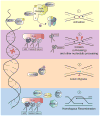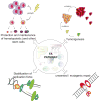Fanconi anaemia and the repair of Watson and Crick DNA crosslinks
- PMID: 23325218
- PMCID: PMC3700363
- DOI: 10.1038/nature11863
Fanconi anaemia and the repair of Watson and Crick DNA crosslinks
Abstract
The function of Fanconi anaemia proteins is to maintain genomic stability. Their main role is in the repair of DNA interstrand crosslinks, which, by covalently binding the Watson and the Crick strands of DNA, impede replication and transcription. Inappropriate repair of interstrand crosslinks causes genomic instability, leading to cancer; conversely, the toxicity of crosslinking agents makes them a powerful chemotherapeutic. Fanconi anaemia proteins can promote stem-cell function, prevent tumorigenesis, stabilize replication forks and inhibit inaccurate repair. Recent advances have identified endogenous aldehydes as possible culprits of DNA damage that may induce the phenotypes seen in patients with Fanconi anaemia.
Conflict of interest statement
The authors declare no competing financial interests.
Figures


References
-
- Ceccaldi R, et al. Bone Marrow Failure in Fanconi Anemia Is Triggered by an Exacerbated p53/p21 DNA Damage Response that Impairs Hematopoietic Stem and Progenitor Cells. Cell Stem Cell. 2012;11:36–49. doi: 10.1016/j.stem.2012.05.013. S1934-5909(12)00247-0 [pii] This study identifies activation of the p53/p21 axis as a major contributing factor to loss of hematopoeitic stem cells in Fanconi anemia. - DOI - PMC - PubMed
Publication types
MeSH terms
Substances
Grants and funding
LinkOut - more resources
Full Text Sources
Other Literature Sources
Molecular Biology Databases

